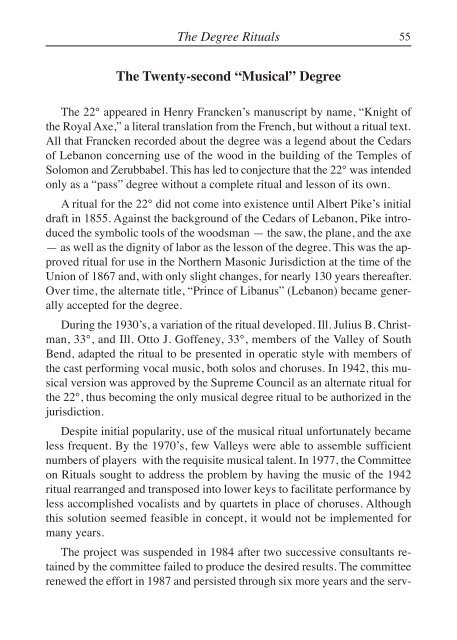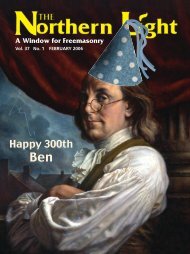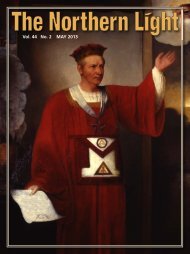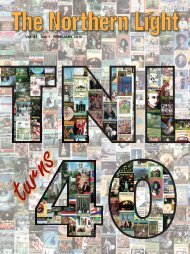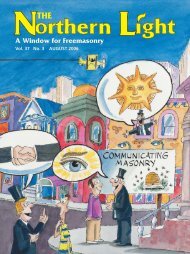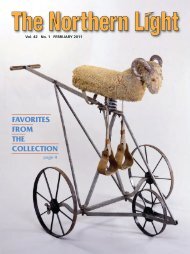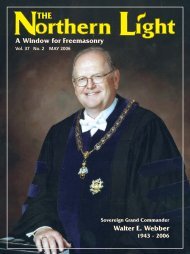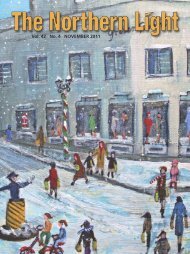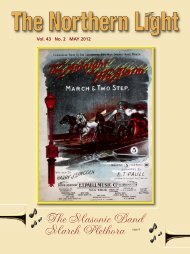The Degree Rituals The Supreme Council, 33 ... - Scottish Rite, NMJ
The Degree Rituals The Supreme Council, 33 ... - Scottish Rite, NMJ
The Degree Rituals The Supreme Council, 33 ... - Scottish Rite, NMJ
Create successful ePaper yourself
Turn your PDF publications into a flip-book with our unique Google optimized e-Paper software.
<strong>The</strong> <strong>Degree</strong> <strong>Rituals</strong><br />
<strong>The</strong> Twenty-second “Musical” <strong>Degree</strong><br />
<strong>The</strong> 22° appeared in Henry Francken’s manuscript by name, “Knight of<br />
the Royal Axe,” a literal translation from the French, but without a ritual text.<br />
All that Francken recorded about the degree was a legend about the Cedars<br />
of Lebanon concerning use of the wood in the building of the Temples of<br />
Solomon and Zerubbabel. This has led to conjecture that the 22° was intended<br />
only as a “pass” degree without a complete ritual and lesson of its own.<br />
A ritual for the 22° did not come into existence until Albert Pike’s initial<br />
draft in 1855. Against the background of the Cedars of Lebanon, Pike introduced<br />
the symbolic tools of the woodsman — the saw, the plane, and the axe<br />
— as well as the dignity of labor as the lesson of the degree. This was the approved<br />
ritual for use in the Northern Masonic Jurisdiction at the time of the<br />
Union of 1867 and, with only slight changes, for nearly 130 years thereafter.<br />
Over time, the alternate title, “Prince of Libanus” (Lebanon) became generally<br />
accepted for the degree.<br />
During the 1930’s, a variation of the ritual developed. Ill. Julius B. Christman,<br />
<strong>33</strong>°, and Ill. Otto J. Goffeney, <strong>33</strong>°, members of the Valley of South<br />
Bend, adapted the ritual to be presented in operatic style with members of<br />
the cast performing vocal music, both solos and choruses. In 1942, this musical<br />
version was approved by the <strong>Supreme</strong> <strong>Council</strong> as an alternate ritual for<br />
the 22°, thus becoming the only musical degree ritual to be authorized in the<br />
jurisdiction.<br />
Despite initial popularity, use of the musical ritual unfortunately became<br />
less frequent. By the 1970’s, few Valleys were able to assemble sufficient<br />
numbers of players with the requisite musical talent. In 1977, the Committee<br />
on <strong>Rituals</strong> sought to address the problem by having the music of the 1942<br />
ritual rearranged and transposed into lower keys to facilitate performance by<br />
less accomplished vocalists and by quartets in place of choruses. Although<br />
this solution seemed feasible in concept, it would not be implemented for<br />
many years.<br />
<strong>The</strong> project was suspended in 1984 after two successive consultants retained<br />
by the committee failed to produce the desired results. <strong>The</strong> committee<br />
renewed the effort in 1987 and persisted through six more years and the serv-<br />
55


